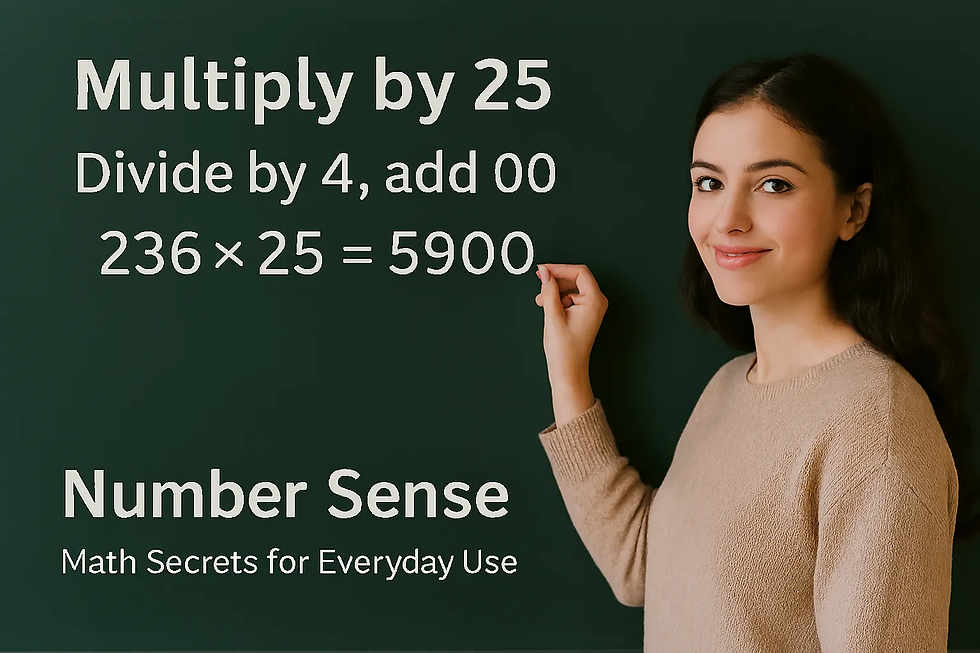Number Sense
- C. L. Nichols

- 1 day ago
- 3 min read
Math Secrets for Everyday Use

Easy Math Tricks That Save Time and Make You Look Smart Without a Calculator
Numbers are everywhere. Receipts, recipes, gas prices, and weekly budgets.
We rely on calculators or apps to crunch them. A few mental math tricks make everyday life smoother.
That’s number sense! Build simple math habits to make smart decisions.
Look at some useful mental math tricks. Try a few and see which stick.
Multiply by 25
Divide the number by 4 and add two zeroes.
250 × 25 → 250 ÷ 4 = 62.5 → Add two zeroes: 6250
Works like magic because 25 is one-fourth of 100, so the shortcut uses that relationship.
Multiply by 5 with Half and Zero
Divide the number by 2 and add a zero.
60 × 5 → 60 ÷ 2 = 30 → Add a zero: 300
For smaller numbers, you can also just halve and double:
12 × 5 → 6 × 10 = 60
Round and Adjust
When a number feels hard to multiply, round it up or down, then adjust.
49 × 6 → Round 49 to 50: 50 × 6 = 300 → Subtract 1 × 6 = 6 → Final answer: 294
Multiply by 99
Multiply by 100, then subtract the original number.
37 × 99 → 37 × 100 = 3700 → Subtract 37 → 3663
Fast Percent Calculations
Percent questions come up with tips, tax, and discounts.
10% of a number → Just move the decimal one place left.
10% of 480 = 48
5% of a number → Get 10%, then halve it.
5% of 480 = 48 ÷ 2 = 24
15% of a number → Combine 10% and 5% Example: 15% of 480 = 48 + 24 = 72
Square Numbers Ending in 5
Multiply the first digit(s) by the next number up, then attach 25.
3⁵² → 3 × 4 = 12, add 25 → 1225 8⁵² → 8 × 9 = 72, add 25 → 7225
Double and Halve
Double one number and halve the other in multiplication.
16 × 25 → 8 × 50 = 400 → Or 4 × 100 = 400
Break Big Numbers Into Chunks
62 × 34 Break it down: → 60 × 34 = 2040 → 2 × 34 = 68 Add: 2040 + 68 = 2108
Multiply by 11
Separate the digits, add them together, and place the sum in the middle.
36 × 11 → 3 + 6 = 9 → Answer: 396
74 × 11 → 7 + 4 = 11 → Place 11 in the middle, adjust → 814
(That one requires a carryover.)
Fast Doubling with Zeros
When multiplying numbers by 20, 30, 40, etc., you can use doubling and a zero trick.
43 × 20 → Double 43 = 86 → Add a zero = 860
43 × 30 → Triple 43 =129 → Add a zero = 1290
Multiplying by 9
Multiply by 10, then subtract the original number.
28 × 9 → 28 × 10 = 280 → 280 − 28 = 252
Dividing by 5
Multiply by 2 and then move the decimal one place left.
135 ÷ 5 → 135 × 2 = 270 → Move decimal left → 27.0
Squaring Numbers Near 100
Use this when squaring numbers like 98, 101, etc.
10²² → Take 100 + 2 → 10⁰² = 10000 → 2 × 100 × 2 = 400 → Add 4 (²²) = 10000 + 400 + 4 = 10404
Multiplying by 12
Multiply by 10, then double the original number and add it.
23 × 12 → 23 × 10 = 230 → 23 × 2 = 46 → 230 + 46 = 276
Multiplying Three Digits by Single Digits (Estimate)
Break it into hundreds, tens, and ones.
243 × 6 → 200 × 6 = 1200 → 40 × 6 = 240 → 3 × 6 = 18 → Add: 1200 + 240 + 18 = 1458
Addition with Rounded Numbers
Round one number, subtract the difference later.
398 + 67 → Round 398 to 400 → 400 + 67 = 467 → Subtract the 2 you added = 465
Check Multiples with Digit Sums
Quick checks for divisibility:
If the sum of digits is divisible by 3 or 9, the number is too.
729 → 7+2+9 = 18 → divisible by 9
If a number ends in 0 or 5, it’s divisible by 5.
The Rule of 11 in Reverse
To see if a number is divisible by 11:
Alternate-add and subtract digits. If the result is divisible by 11, so is the number.
506 → 5–0 + 6 = 11 → divisible by 11
With number sense, simple patterns lead to powerful results. These tricks save time and energy. Get comfortable with the ones that stick.
Comments